It is hard to believe that the Valiant 40 was introduced 45 years ago. Designed by Robert Perry, the Valiant has attained legendary status because, as Perry said, “It’s been everywhere and done just about everything.” The story of how the Valiant 40 came to be will inspire all young dreamers who scribble sailboat designs on napkins. Nathan Rothman, Bob Perry and Stanley and Sylvia Dabney were friends living in Seattle and dreaming of boats and islands. Rothman wanted to build boats, Perry, who livedaboard the Dabney’s Islander 36, wanted to design them, and the Dabneys wanted a more serious boat to cruise the world. What evolved from this friendship was the VALIANT 40.
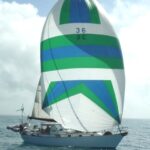
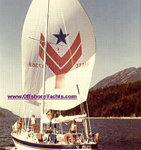
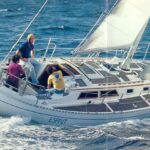
Perry’s design which has been dubbed the first genuine performance cruiser, was a bit of a change for a blue water cruising boat. Instead of a full keel and attached rudder, the Valiant featured a powerful fin keel and skeg hung rudder. Above the waterline, the Valiant 40 was quite traditional, with a hull shape based on a photo of Holger Danske, a lovely double-ender designed by Aage Nielsen. Perry confesses that the famous cone stern was incorporated into the boat more for its looks than its seakeeping characteristics and because of the surprising popularity of the Westsail 32. “The Westsail changed the world,” Perry said. “Cruising hit the mainstream when the boat was on the cover of Time Magazine. Everybody wanted a double-ender.” Perry’s canoe stern had much better hydrodynamics than the sharper-ended Westsail, and his version of the double-ended design influenced the look of serious cruising boats for years.
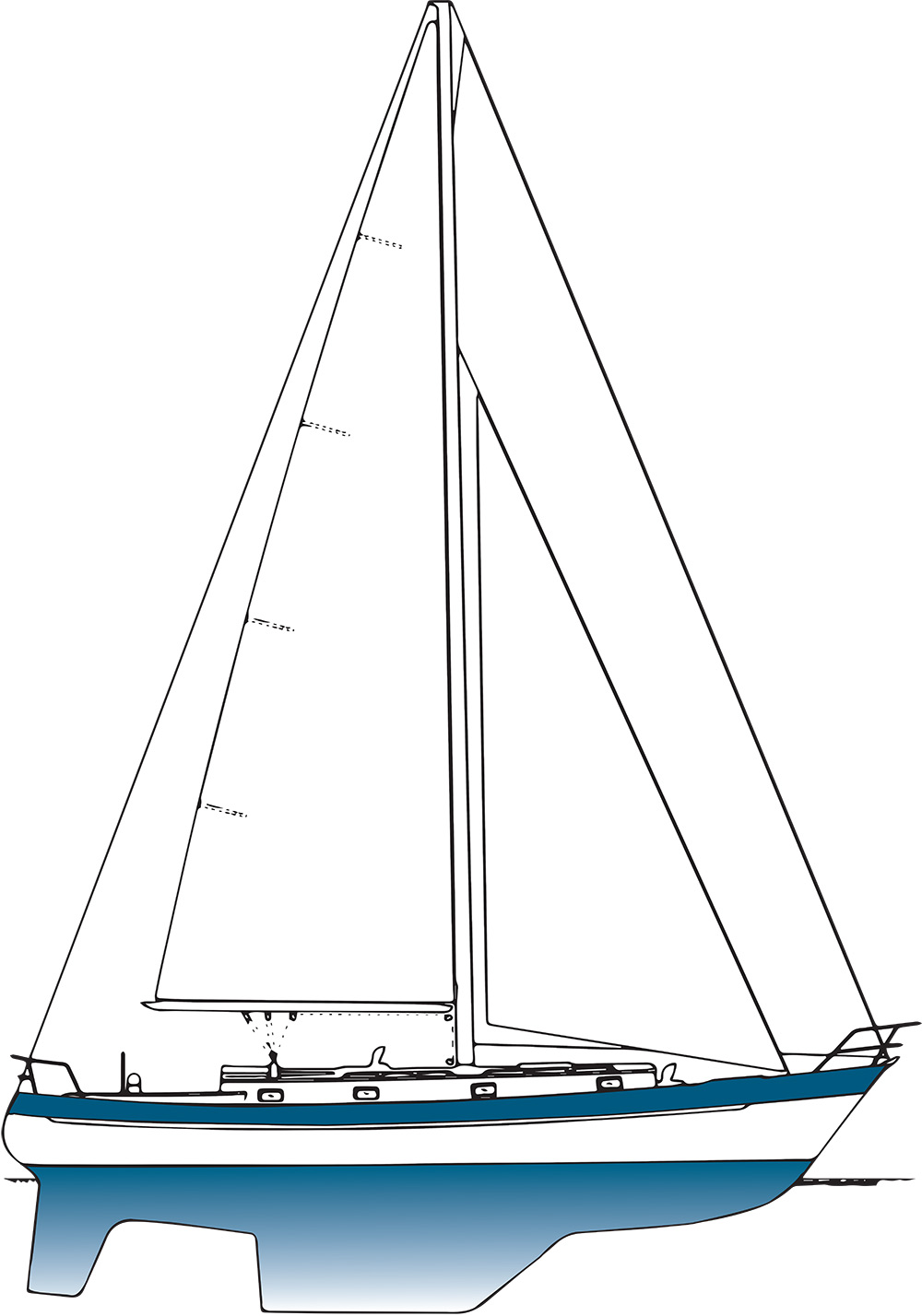
Rothman contracted with Uniflite, primarily a powerboat builder in Bellingham, Washington, to build the boat because he was unable to find enough resin during the oil crunch years of ’73 and ’74 to build it himself. After tooling up for production, the first Valiant 40 rolled off the lines in late 1974. The boat has been a top choice of cruising sailors for decades, but Valiants stellar blue water reputation is also a result of its success in single-handed ocean races. Francis Stokes, aboard Moonshine, won his class in the 1980 OSTAR. Dan Byrne, a retired journalist and inexperienced sailor, sailed Valiant 40 hull No. 1 in the inaugural BOC Around the World Race. Mark Schrader completed an epic circumnavigation in a Valiant 40 in 1983.
Unfortunately, Valiant’s reputation took a hit when Uniflite’s construction experienced severe blister problems after it changed resins in the mid 70’s. Valiant sold to Sam Dick Industries, which later sold to Uniflite. It was purchased by a Valiant dealer in N. Texas and after building a few hulls in Washington, moved to production to Lk. Texoma, near the Oklahoma border. …and the boat remained in production until 1993, when it was replaced by an updated 42. Some claim that the Valiant 40 is technically still in production because the new 42 uses the same hull built from the same tooling. The 42 does have a new deck and includes a short bowsprit adding 2 feet to the LOA. All told, 200 Valiant 40.s were built and sold.
First Impressions
The Valiant 40 was conceived as a boat for world cruising and ocean passage making and it looks the part. From the handsome canoe stern to the proud bow, the 40 has a sweet sheerline, a fine entry and a relatively long LWL, especially for its day. The cockpit is anything but spacious and the cabintrunk extends well forward and is a bit boxy by today’s standards. Rigged as a cutter, the 40 carries 772 square feet of sail area and is surprisingly nimble for a boat that weighs 22,500 pounds.
This review will focus on older Valiant 40’s, the boats built by Uniflite, as most Valiant 40’s exceed the self-imposed cap of $100,000 market price for boats reviewed in this column.
Construction
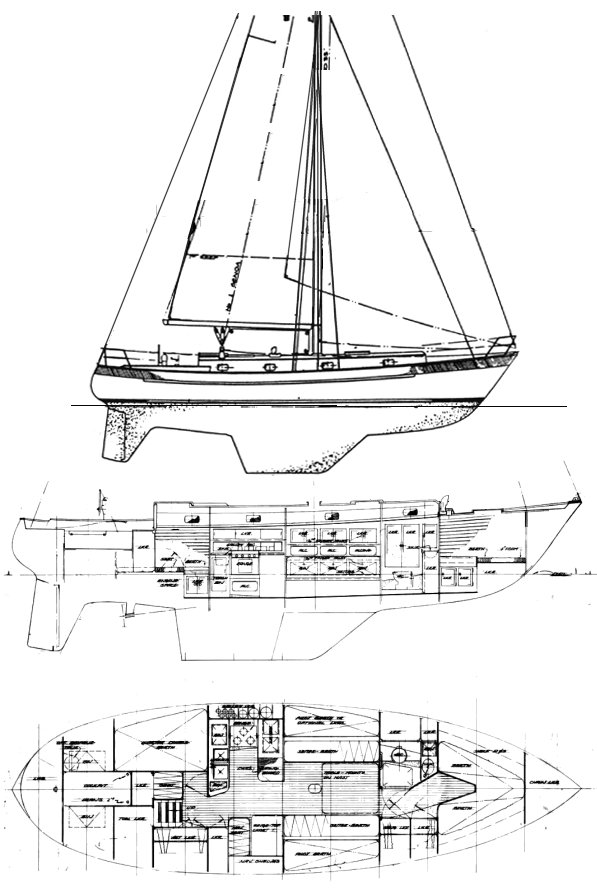
Like most boats of this era, the Valiant 40 hull was a solid but rather thick, hand-laid-up fiberglass laminate. The deck was balsa cored. The hull-and-deck joint is robust and forms a box with the molded bulwark. The top of the bulwark has an inward flange and the deck forms the forward face of the bulwark and is joined to the hull with an outward flange. The joint is through-bolted and covered with a teak caprail.
A series of transverse floors are glassed to the hull for athwartship support. Unlike other production builders that use fiberglass liners or pans, the Valiant 40 was traditionally built by fiberglassing bulkheads and furniture faces directly to the hull. The lead keel, which went through three design changes, is an external lead casting bolted to a substantial keel form/stub. Perry changed the keel at Uniflite’s request because it was expensive to build. The second keel lowered the vertical center of effort. The last keel redesign included input from Dave Vacanti and is an improved foil shape. The skeg is a steel piece, encased in fiberglass and externally fastened to the hull; it is not part of the hull mold.
What To Look For
You can’t mention used Valiant 40’s without talking about blister problems. According to Stanley Dabney, who not only was one of the founding fathers and Valiant’s Vice President and Sales Manager for the (5 years) but has also owned hull #9, Native Sun, for 25 years, there is a lot of misinformation about what caused the blistering. Dabney, who with his wife Sylvia, owns Offshore Atlantic Yachts in Riviera Beach, Florida, explained that the commonheld belief that Uniflite changed fire retardant resin, thus causing blisters, is not quite right. Uniflite had been using fire retardant resin already, but the blisters were a result of a switch in resin suppliers during the oil crunch of the mid ’70’s. The new resin wasn’t up to standard.
Dabney sells eight to 10 used Valiants every year and most of them 40’s. The blister problem can be traced from 1976 through early 81. Almost all boats during this period blistered to some extent, some badly, both above and below the waterline. Early boats, which also used fire retardant resin, have never blistered and newer boats rarely. He solved the problem in 1984 when he switched to isophthalic resin -carefully monitored the catalyzation and included epoxy barrier coats. According to Dabney, there is only one way to properly repair a badly blistered Valiant. You have to peel the boat down to a mere shell and then fiberglass it. It is a big job. Not surprisingly the market price of the Valiant 40 is directly related to the year build. An early 1975 Valiant 40 in good shape will command more money than a 1979 or 1980 boat, even if they had only minor blistering. Indeed, a used Valiant 40 that has had only mild blisters can be a great value.
There are a few other common problems to look for when considering an older Valiant 40. The aluminum water and fuel tanks have not aged well and may need to be replaced. The chainplates one early boats were on the light side and should be upgraded. Occasional delamination in the subdeck is a problem, particularly around the chainplates, but this of course is common on any old boat with a balsa or plywood core. Be sure to check the standing rigging and replace any original fittings. Later boats had optional rod rigging, which is harder to check. If it is more than 15 years old, have a rigger inspect the terminal ends. The irony of the blister woes that haunt older Valiants to this day is that they have aged very well, considering that most have been sailed hard and logged thousands of miles.
The Valiant 40 was designed as a cutter, as opposed to what Perry later called a double headsail sloop. The mast is located well aft and the boom is not overly long, which makes for a manageable mainsail. Most boats used intermediate stays to support the staysail, although some owners have opted for runners to avoid chafe. Early boats featured end-boom sheeting, which tended to increase the weather helm. After a midboom sheeting arrangement was added, which opened up the cockpit and eased the helm.
The original molded nonskid pattern, stout bulwark, well-supported stanchions and double lifelines make it easy to move about the deck in any kind of weather. Early boats had a single bow roller. Later a double roller was standard, The dockline leads are hawsepipes through the bulwark and very strong. Throughout the long production run, Valiant used top-quality suppliers, from Lewmar and Barient to Edson and Harken.
Down Below
The Valiant interior arrangement was also innovative in its day and featured two private double cabins. After dropping below, the aft cabin is immediately to port. There is a small seat and good locker storage. Opposite is a hanging locker and on some Valiants, a pantry storage area. The nav station is located forward to starboard, with the galley opposite. The galley is U-shaped with double sinks, a three-burner stove and a large icebox. Some boats have upgraded the stove and added a refrigerator/freezer. There is lots of storage space above the stove and under the sinks.
The saloon design is straightforward, with opposite facing settees that can be a sea berth on either tack. There is a pilot berth to port. The seat backs are a bit abrupt and a centerline table can be cumbersome. The head and shower are to port and there is a hanging locker opposite. The V-berth is good-sized when the filler cushion is in place. Valiant finished most of its boat with white Formica which is nicely accented with teak trim and veneers. This is both practical and visually appealing as it brightens the interior. The original workmanship was well-done, not fancy but functional, and the 20-year-old 40’s that I have climbed through still look good below.
Engine
The first Valiant 40’s came with a Westerbeke 4107, which was a good engine for the boat. Other engines used for the boat were the Perkins 4108, a Westerbeke 50, which was a notoriously fickle engine, and late in production, the Volvo 2003. Engine access is good, from behind the companionway and through the aft cabin. I’m not a fan of V-drive transmission, but certain hull shapes and interior arrangements dictate their use. The fuel capacity, in two aluminum tanks, is approximately 100 gallons. A consideration when looking at older Valiants is the prospect of repowering. When the Dabneys recently repowered Native Sun, they exchanged the Westerbeke 4107 with 6,500 hours of running time, for a Perkins 4108 that had the same footprint.
Under Sail
The Valiant 40 has earned its enviable reputation by consistently making fast offshore passages. The cutter rig is well-balanced, with just a bit of weather helm that actually assists most wind-vane steering units. The cutter also offers versatility under sail. Flying a high-cut yankee on the forward headstay allows it to be easily shortened. The staysail can then carry the load as the wind pipes up. Although not particularly close-winded by today’s standards, the Valiant 40 tracks well to weather.
A few years ago I delivered a 40 from St. Martin in the West Indies, to Buzzard’s Bay, Massachusetts. The winds were fresh on the first leg and we reeled off consecutive 160-mile days on a beam reach. We ran into a gale in the Gulf Stream on the second leg. I was impressed with the Valiant’s easy motion as we gradually shortened sail until we were down to a double-reefed main and the staysail. I was forced to hand steer for days, but the helm was balanced and I was able to tie it off when I needed a break. The sailing characteristics are the prime reason for buying a used Valiant 40.
Conclusion
The Valiant 40 is a genuine blue water cruiser that can, when purchased carefully, be had for about a third of what it would cost to buy a comparable new boat. Badly blistered old boats can be bought for around $80,000, but be prepared for a major repair project. Those boats with minor blisters sell for at least $100,000. For a blister-free Valiant 40, post 1981 but before construction shifted to Texas, expect to pay around $140,000.
Support
Without doubt, the best source of information for used Valiants is from Stanley and Sylvia Dabney. You can reach them at (561)818-9235 or on the Web at www.OffshoreYachts.com.
John Kretschmer is a well respected writer and yacht delivery captain, who has been published in major sailing magazines and periodicals. He has recently completed his book, “Flirting with Mermaids:How I’ve Kept From Getting a Real Job, Most of My Adult Life”.
